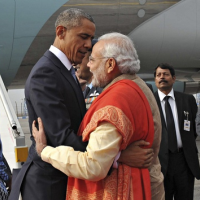Nuclear Deal Reset to Boost India-US Strategic Partnership
 In a departure from protocol, Modi personally received Obama at the airport in Delhi (photo: Reuters)
In a departure from protocol, Modi personally received Obama at the airport in Delhi (photo: Reuters)
U.S. President Barack Obama’s visit to India was expected to be largely symbolic. The first U.S. president to be the chief guest at a Republic Day parade, most observers expected plenty of hype with little chance of any ‘big bang’ agreement. The reality has turned out quite different. The ‘lame duck’ U.S. president and his host Prime Minister Narendra Modi – whose reforms are being stymied by an antagonistic Rajya Sabha – announced on Sunday that they would reset the civilian nuclear deal that has hung fire for 7 years.
The groundbreaking 2008 pact between their respective predecessors – George W Bush and Dr. Manmohan Singh – had made India the sixth "legitimate" atomic power and marked a high point in Indo-U.S. relations. Yet it failed to deliver on a promise of business for U.S. companies and of an upsurge in nuclear power for India’s energy-starved economy, because of India's reluctance to shield suppliers from liability.
The Nuclear Liability Act passed by parliament in 2010 reflects the country’s memory of the Bhopal industrial disaster in 1984, but it scared off U.S. companies from setting up nuclear reactors in India and became instead one of the major irritants in Indo-U.S. relations.
With an eye on their legacy, and amidst a developing rapport between the two leaders, Obama and Modi announced plans to unlock billions of dollars in nuclear trade and to deepen defence ties.
In a departure from protocol, Modi personally received Obama at the airport in Delhi on Sunday morning and extended him a bear hug. Both leaders hugged each other again after their joint press conference later that day.
According to Reuters, the bonhomie was a remarkable spectacle, given that a year ago Modi was persona non grata in Washington and was banned from visiting the United States for nearly a decade after deadly Hindu-Muslim riots on his watch in 2002 when he was chief minister of Gujarat.
Obama's presence at the Republic Day parade on Monday – at Modi's personal invitation – marks the latest upturn in a roller-coaster bilateral relationship that just a year ago was in tatters. Bickering over protectionism culminated in a fiery diplomatic spat in 2013 and the abrupt departure of the U.S. ambassador from New Delhi, who has only just been replaced.
The two leaders emerged from their talks on Sunday with a 10-year framework for defence ties and deals on cooperation that included the joint production of drone aircraft and equipment for the C-130 military transport plane.
Other deals ranged from an Obama-Modi hotline - India's first at a leadership level - to financing initiatives aimed at helping India use renewable energy to lower carbon intensity.
Progress on the nuclear deadlock, it appears, may finally unlock the full potential of partnership between the world's two largest democracies that are “natural allies” in many ways.
- Karan Singh
To Learn More:
PM Narendra Modi and US President Barack Obama find the N-key (Hindustan Times)
Chemistry over history: nuclear logjam clears, big push in defence (by Shubhajit Roy, Indian Express)
Rain on India's parade, but Obama visit keeps spirits high (by Sanjeev Miglani, Reuters)
Explained: Nuclear deal moves, but some way still to go (by Praveen Swami, Indian Express)
Why Obama's India Republic Day visit is significant (by Pramit Pal Chaudhuri, BBC News)
- Top Stories
- Controversies
- Where is the Money Going?
- India and the World
- Appointments and Resignations
- Unusual News
- Latest News
- India College Chain’s Expansion into U.S. Draws Opposition from Massachusetts Officials over Quality of Education
- Milk Shortages in India Tied to Release of New Movies Featuring Nation’s Favorite Stars
- Confusion Swirls around Kashmir Newspaper Ban in Wake of Violent Street Protests
- Polio-Free for 5 Years, India Launches Vaccine Drive after Polio Strain Discovery
- New Aviation Policy Could Increase Service, Lower Ticket Prices






Comments